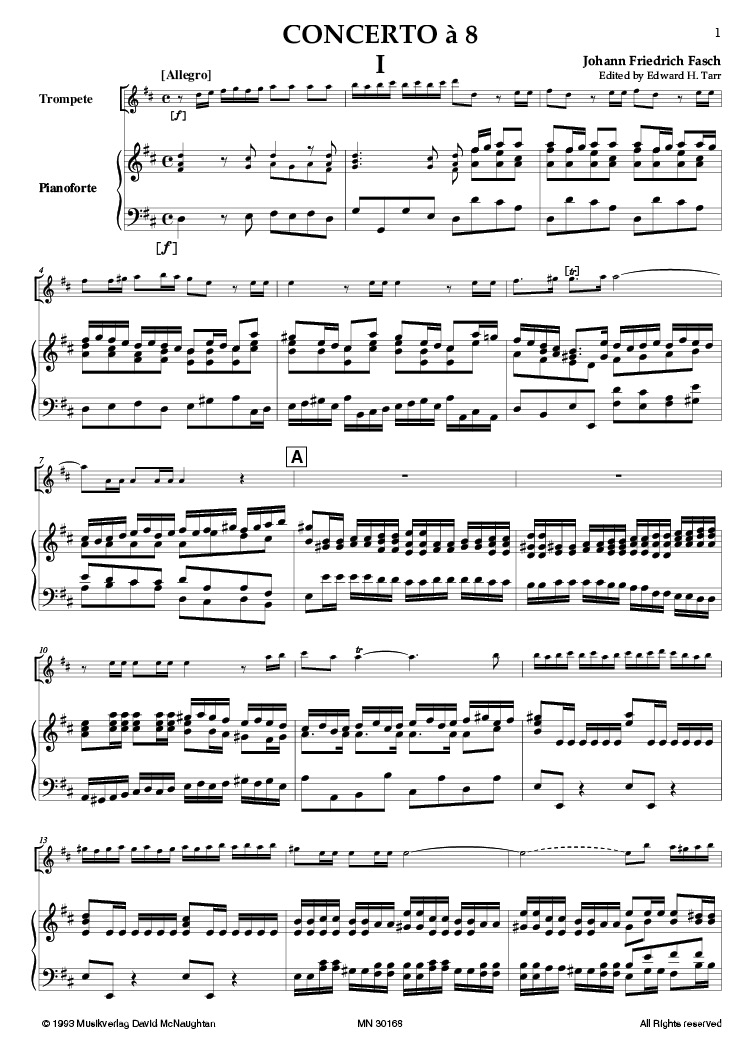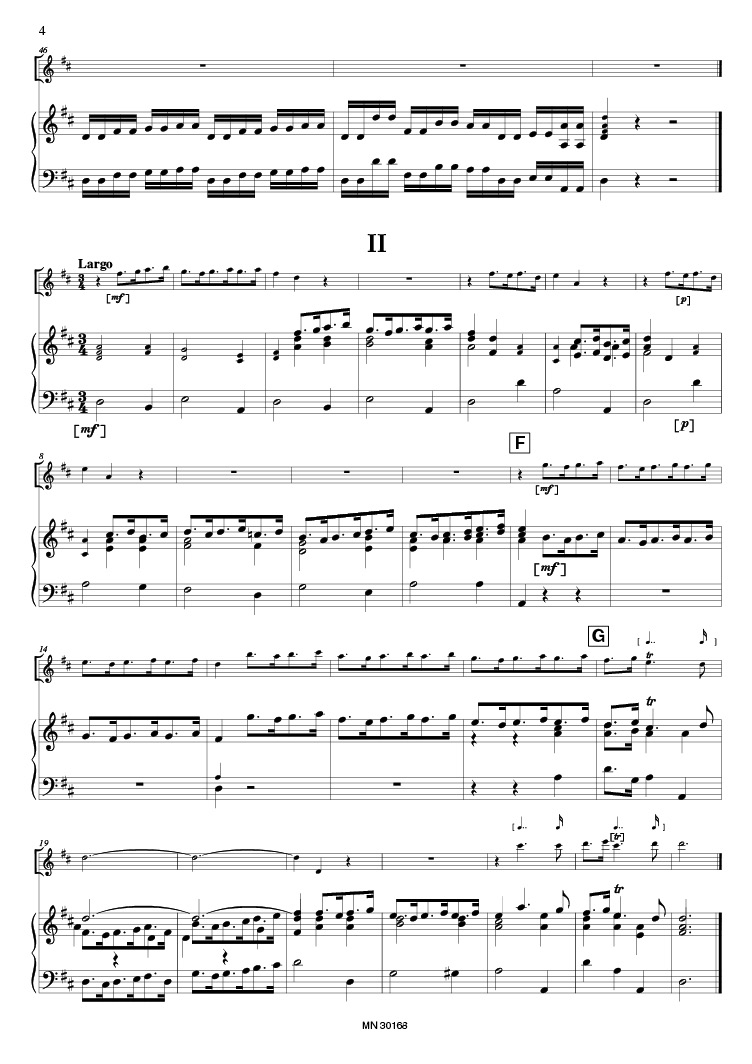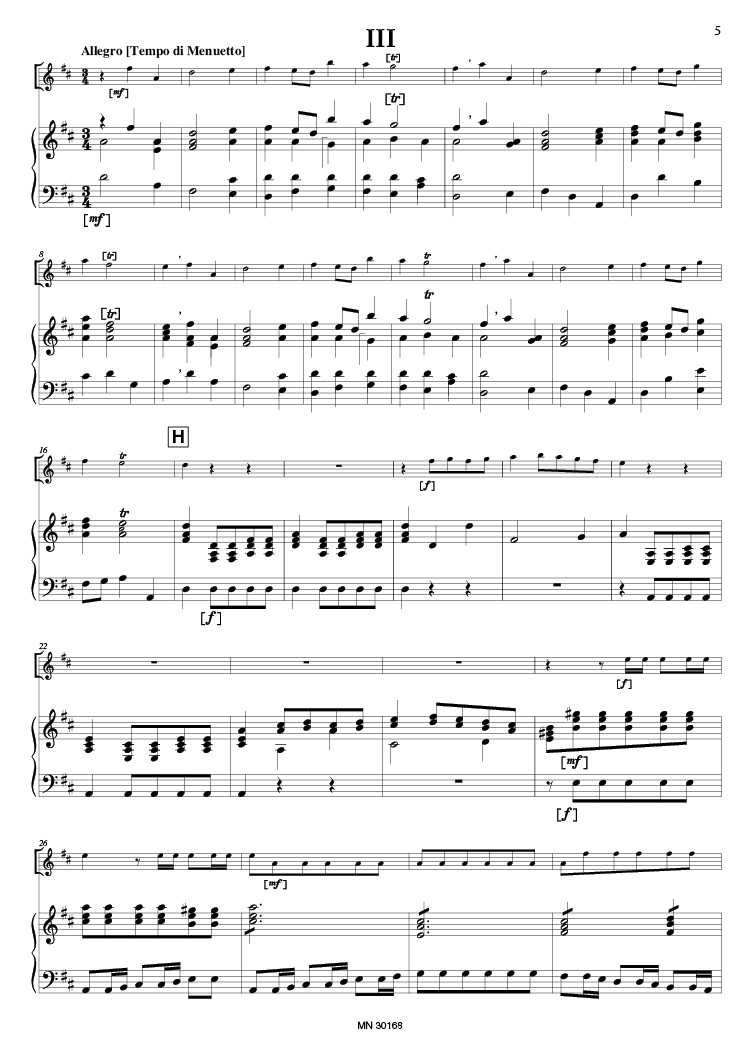
Fasch Concerto à 8 D-dur
Instrumentation: Trumpet, 2 Oboes, Strings, B.c.Difficulty (I-VI): V
Parts for: Trumpet in D and piccolo A, 2 Oboes, Strings 4324, B.c., Score
Series: Edward Tarr Brass
Editor: Edward H. Tarr
Johann Friedrich Fasch (1688-1758) was highly regarded by J. S. Bach and today is enjoying something of a renaissance. He was born into a family of cantors and theologians and received his first musical impressions as a boy soprano in Suhl and Weissenfels. Many famous trumpeters were either trained or employed at the the Weissenfels court, among them both Altenburgs, Johann Caspar (1689-1761) and the theorist Johann Ennst (1734-1801), Gottfried Reiche (1667-1734), who later participated in the first performances of Bach's Leipzig works, and, last but not least, three brothers-in-law and the father-in-law of Johann Sebastian Bach, Christian August Nicolai (who earned special mention hy J. E. Altenburg and died in 1760), Andreas Krebs, Georg Christian Meissner and Johann Caspar Wülcken. We cannot exclude that the boy Fasch got to know and perhaps even to love the trumpet there. He attended St. Thomas' school during the time in which Bach's predecessor Johann Kuhnau (1660-1722) was Cantor, and in his first compositional efforts was influenced by his older friend Georg Philipp Telemann (1681-1767), who was studying at the university there. During his Leipzig years, Fasch founded the Collegium musicum, which quickly became an important municipal musical institution in which important Bach works were later to receive their first performances.
After various appointments, in 1722 Fasch became court composer in Zerbst, where he remained for the rest of his life. There he wrote 12 yearly cycles of church cantatas, many masses, and four operas, nearly all of which have been lost, as well as 61 concertos, some symphonies and sonatas, and more than 90 suites, most of which have survived. As a composer he is said to have been forwardlooking; some of his innovations, such as the abandonment of the old fugal style of writing in favor of thematic style, or the appearance of dual themes in some of his concertos, anticipate stylistic elements of the later Classical period. However, he did not greatly influence posterity, for in Zerbst - despite his contact with other centers such as Dresden and Berlin - he lived in relative isolation, and none of his compositions were ever printed during his lifetime.
In Zerbst, Fasch had copies made of many of his works, sending them to various other places. Darnstadt alone, besides the present Concerto, has several other works for trumpet by him, mostly involving more than one solo instrument. The present concerto, which has become quite popular in recent times, is a good example of its composer's style. According to Reine Dahlqvist, it was probably written in Zerbst after 1743 for an unknown soloist, perhaps a visiting virtuoso. It is known, for example, that a certain Nicolai (perhaps Bach's brotherinlaw Christian August?) played there once in 1753. The work's original title, significantly, is not "Concerto per tromba", but "Concerto a 8"; although, certainly, the trumpet has a leading role, the oboes also have important parts to play, especially the first oboe. Particular features of this concerto, which can also be found in other of Fasch's works, are its structure, tending towards that of a group concerto, its pervading motoric rhythms, its ritornello with repeated semiquavers and the trumpet interjections between the phrases of the 3rd movement. In this concerto, Fasch's style of composition, influenced by the Italian and French styies, is eloquently displayed. The 1st movement, in the Italian style, is dominated by a ritornello which, with its repeated sixteenthnotes, has been conceived in a manner similar to the one found at the beginning of Bach's Fifth Brandenburg Concerto, although Fasch's ritornello appears for the first time not at the beginning, but towards the middle of the movement. The short 2nd movement features a duet between the trumpet and the 1st oboe before it concludes softly on a breathtakingly high trumpet note. The 3rd movement begins like a French minuet, only to take on Italian characteristics more and more during its course. The minuet theme appears first in the tonic and then at the dominant; in subsequent repetitions - first at the dominant and then in the tonic - it is interrupted every four bars by semiquaver interjections in the trumpet part, mentioned ahove as one of the composer's favourite devices, before the work as a whole concludes with a last statement of the theme in its entirety.



